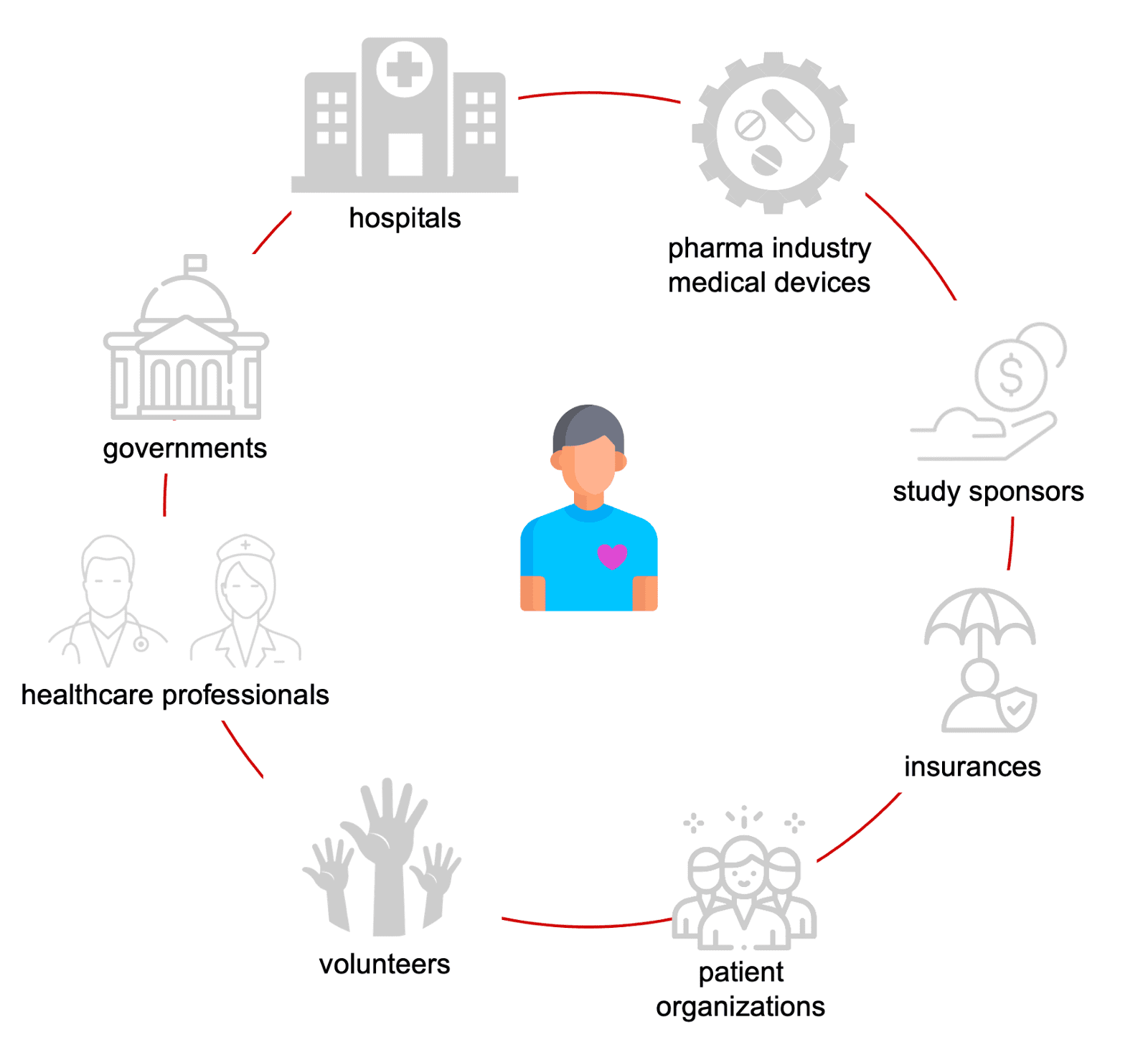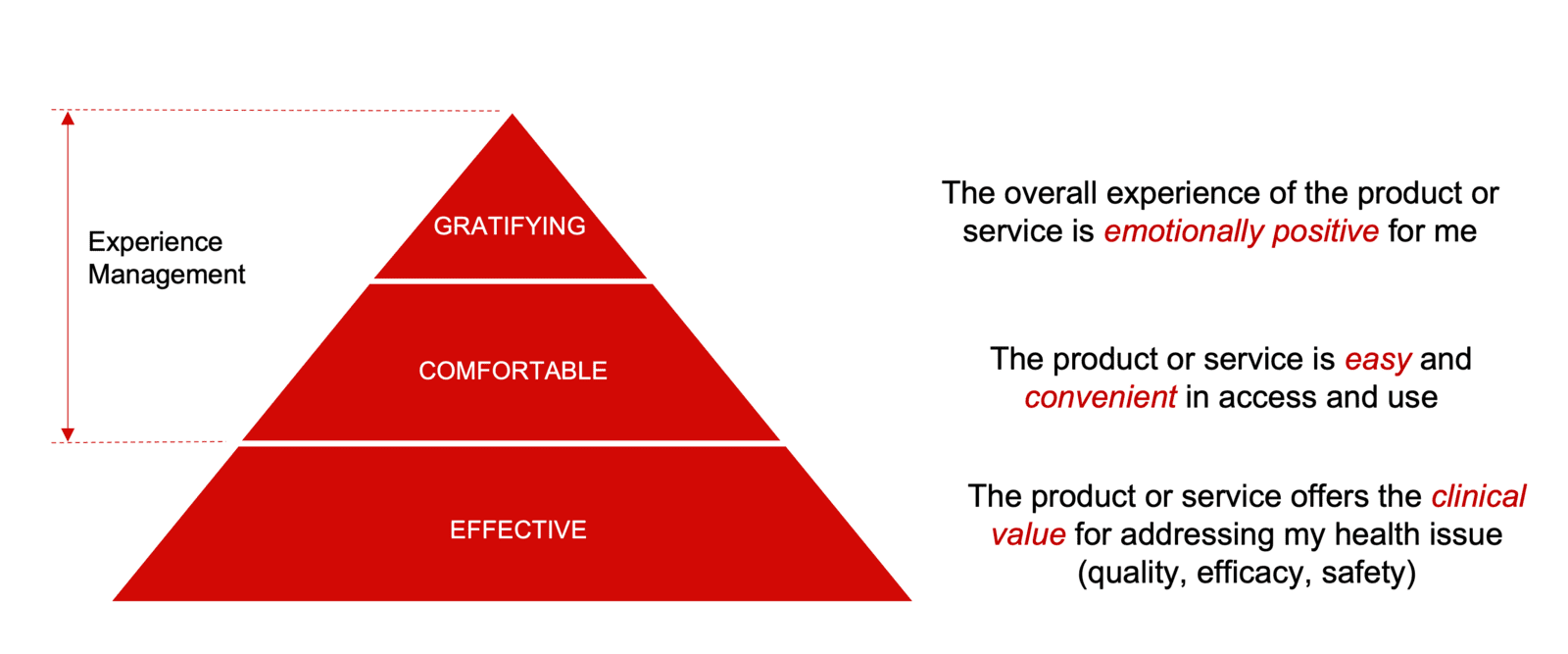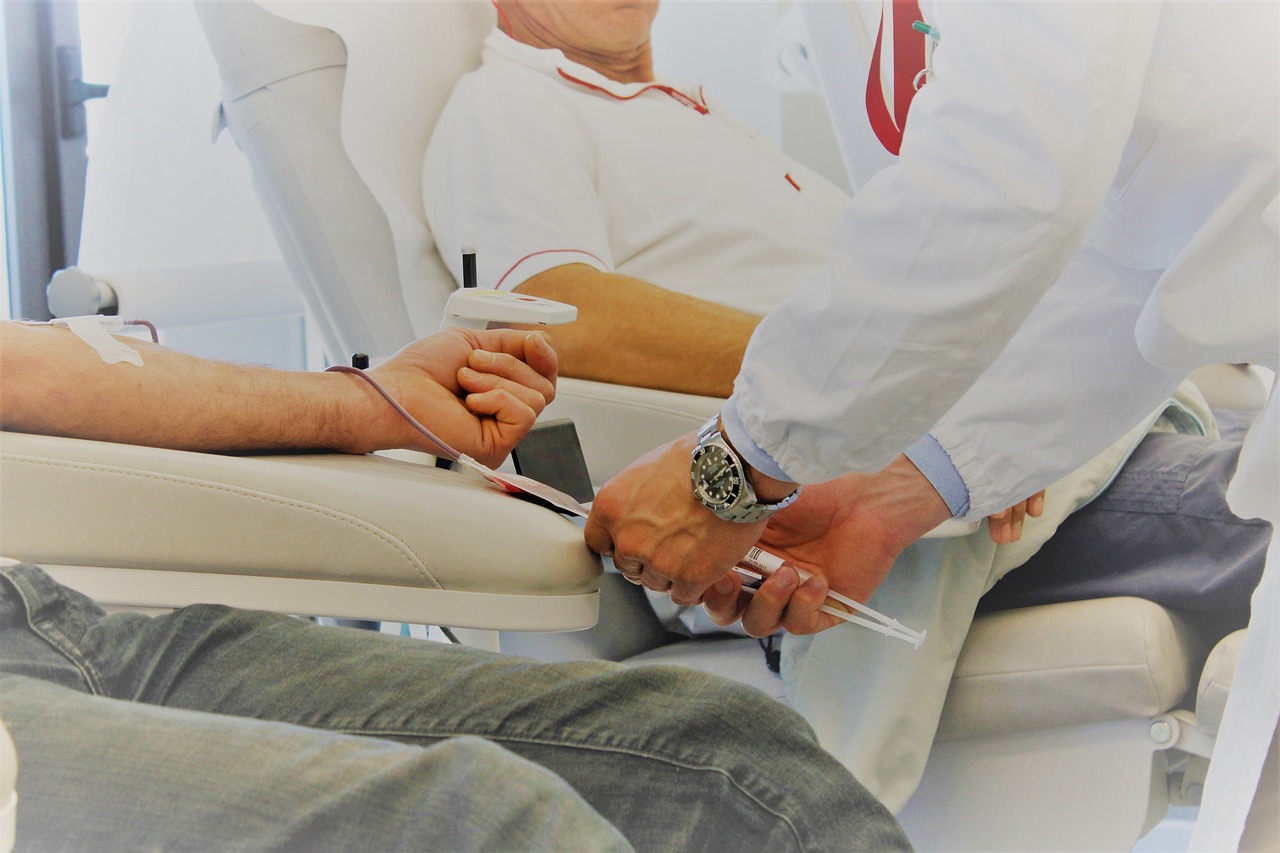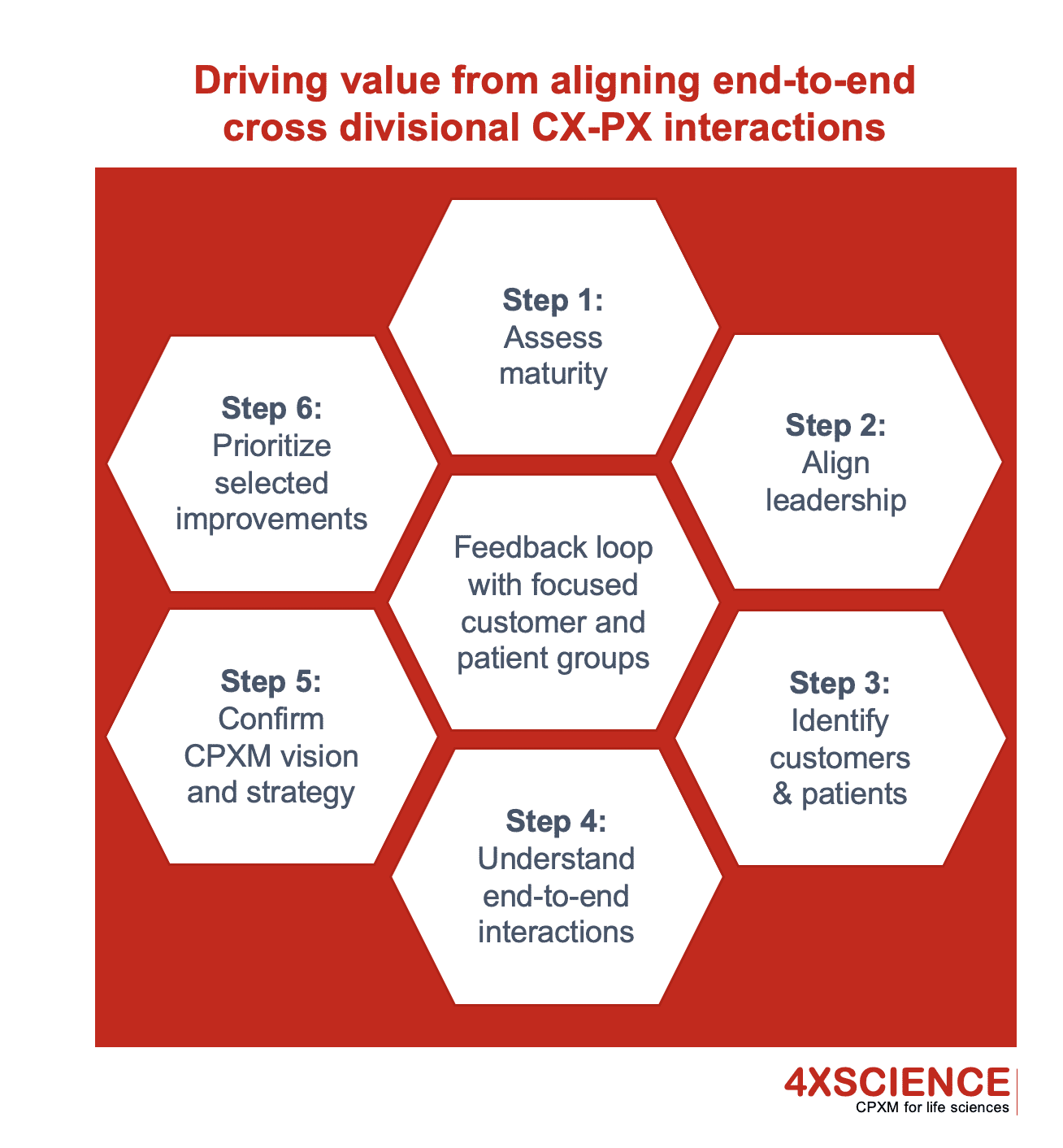CPXM
EXPLAINED
The science behind X.



Integrated Patient and Customer Experience Management from appointment to follow up
CX and PX are entangled across divisions

Patient Experience Management
Managing experiences of patients with your organization. Experiences result from interactions along the journey from appointment, over diagnose and treatment, to follow up of care.
Patients? the patient in need of care including partners, children, family members, patient organizations, caregivers and volunteers
Interactions? anyway a patient can interact in person or virtual e.g.
reading information, making appointment, visiting your organization, checking in, reading website, calling in for support, filling in surveys
Your organization? everything that represents your organization e.g. name, building, employees, medical expertise, medical specialists, nurses, surgeons, treatments, services, processes, management, partners, suppliers, website, brochures
Journey? interactions between your hospital and your patients occur in a journey, across multiple channels, within multiple divisions, prior and after treatment, during life-time. Interactions form touchpoints during multiple patient journeys or pathways.
Experiences? the sum of sensations, thoughts, feelings, emotions, reactions in response to an interaction - impressions that remain.
Customer Experience Management
Likewise, CX refers to managing experiences of customers with your healthcare organization. Also these experiences result from interactions along a journey from identification to continued support.
Customers? existing and potential partners that sponsor your activities or conduct business. Governments, insurance companies, life sciences industry, research institutions, and partner hospitals
Interactions occur when customers are visiting your organization, receiving services, approving funding, evaluating performance, exploring innovations, running clinical trials, paying invoices.

From CX and PX to CPXM

Continued investments in patient experiences are only sustainable if there is a clear benefit for all stakeholders. Most hospitals work intensively with their partners to improve patient experiences from appointment to follow up: they follow government and patient needs for higher quality and more transparency.
However, within a healthcare environment, customers ultimately pay a significant part of the patient's invoice for treatment services. Governments approve budgets allocated to organizations. The interactions with these stakeholders are as important as with patients. Expectations are evaluated and experiences are created.
The management of these experiences is continued and entangled across all divisions. CX and PX become CPXM. The acronym CPXM is a 4XSCIENCE acronym and not widely used yet.
Expectations of patients and customers are rising beyond the clinical outcome
Experiences have become an integrated part of the treatment service and product

Experiences are always present
Patients expect healthcare services and products not only to be effective and safe, they should also be comfortable and gratifying. The clinical outcome is the number one priority, however it is not enough. Empathy, empowering, connecting, simple, being informed, easy and comfort are key elements in healthcare. Patients expect easiness and convenience before, during and after treatments so their overall experience is emotionally engaging. Not only clinical procedures contribute, also your supporting processes have a significant impact.
Likewise, customers expect all interactions with your organization to be easy and convenient. Your supporting processes, people, technology and data have a fundamental impact. As customers are your financial sponsor, these interactions are critical as well.
Experiences are always present, no matter what: for each interaction, patients and customers compare their expectations with their experiences and evaluate interactions as subjective, personal and emotional. The only choice is to manage or ignore this.
The more the clinical outcome of services are equal or personalized, the higher the impact of experience management can be. Experiences are created by services and products, and also by supporting processes before, during and after interactions.
It's not new: CX is everywhere
Experience Management is not new. According to several research studies (e.g. Gartner and Forbes) more than 80% of companies are competing based on customer experiences and not their product exclusively. More and more organizations are competing primarily on the basis of experiences. Most well-known examples? Starbucks, Disney, Amazon, IKEA. On a wider industry scale: car manufacturers, travel agencies, airlines, leisure, retail.
Healthcare is moving as well. A new transformation started.
Patients become more and more empowered: they actively select, decline or promote drug products and services. In the current landscape, customers and patients are expecting more from their providers and brands. In order to follow up on their brand promises, the industry is investing in improved experiences across the ecosystem towards patients and customers. Similar, PX became a hot topic in healthcare, especially hospitals. Politicians and governments expect more transparency on the performance of hospitals. Performance measures and funding allocations have been developed. Hospitals are using PX to improve quality and empower patients. Because it is a right step to do for their patients.
Most hospitals created a "Patient First" mandate in their mission statement.

There is an entire science behind PX and CX to ensure a win-win for all stakeholders
Higher expectations
The transformation is happening at global scale in all life science segments. Big pharma, biopharmaceuticals, vaccines, cell therapies, medical devices, all of them are starting to act. And with them, they involve the entire end-to-end business process including distributors, hospitals, retirement homes, and even the small pharmacies. All of them are investing in improved experiences for their patients and customers. From pre-clinical, over supply chain and commercial to drug administration. Not only once, but for the entire life of a patient and the family. Both patients and customers want to experience a positive relationship when interacting during their journey. Implementing CX and PX allow actors to better interact to the benefit of their customers and patients. With the acronym CPXM, we highlight the fact that CX and PX are entangled across supply chains and must be addressed together end-to-end across divisions from pre-clinical to commercial.

Advancing technologies
The higher customer and patient needs are complemented by the immense acceleration of new digital technologies and innovations. New technologies are used to augment, complement and transform current processes and interactions. And of course, there is AI. Patients are actively participating along their journeys, moments of truth are changing. To stay competitive, all actors must embrace these new options when evaluating their customer and patient journeys. Focusing on services is not enough to meet new customer and patient expectations. Patients do expect more to stay satisfied and loyal. At the same time, these new technologies are being used during early development phases and allow life science actors to accelerate time to market and lower their delivery costs.
A complex landscape
Life science is a complex B2B, B2C and B2P landscape with many actors directly or indirectly interacting with partners. Some actors might need patient interactions for product development purposes, while others might need the same interactions for commercial purposes. In addition, the life science industry has an extremely wide range of interacting therapeutic areas with specific needs. Better experience management accelerates product development, lowers costs, increases revenues and results in improved healthcare for all of us. And the benefits are mutual: even for the small pharmacies and practices in towns, improved customer and patient experiences help to build higher patient satisfaction and loyalty levels.

Options and priorities
Over the last few years, we see a strong growth of tools and solutions acting in the CPXM arena. Some examples of technology options and components to engage customers include surveys, social media management, marketing automation, CPQ, content management, chat services, customer profiling, patient segmentation, cross-channel management, recovery management, patient trial enrolment, digital advertising. The list is endless and for many it is unclear where to start and what to select. Due to the end-to-end complexity, the implementation takes time. However, CX and PX is in the first place not about technology.
The science of X
Some companies deeply understand what customer or patient experience management is all about. Others still question if they need to invest in it or not. Many don't see the close end-to-end link between CX and PX yet. Most have started with active patient engagement and enhanced customer support initiatives to complement their Patient First Mission.
To make it real in execution it is important to understand the science behind X, behind experience management. Design Thinking. Voice of the Customer. Real Word Evidence. Patient Experience Data. PREMS. Inclusive Engagement. Quality of Care. Government funding. Return on Investments. Expectations versus Experiences. Moments of Truth. Peaks End. Ideation. Focus groups. Surveys.
Successful CPXM requires changes in many areas beyond the technology. Silos need to be broken. Similar to other sectors, life sciences need to become much more customer- and patient-centric from early phases onwards. Technology is the easy part of the entire story.
A story that only accelerates. No way back.



